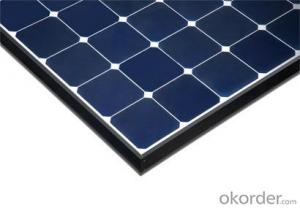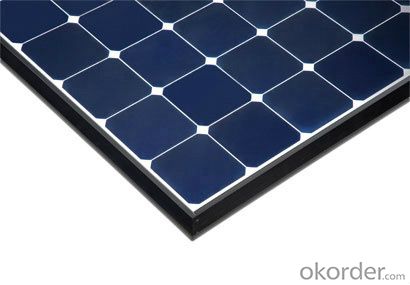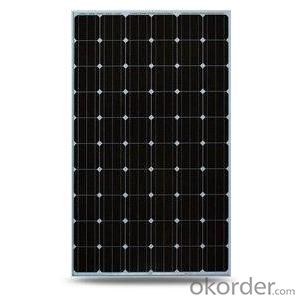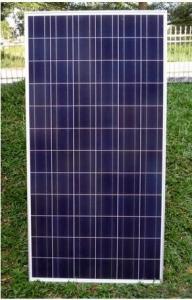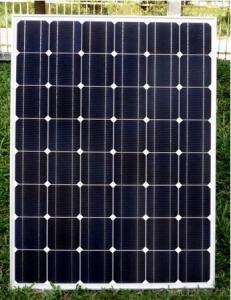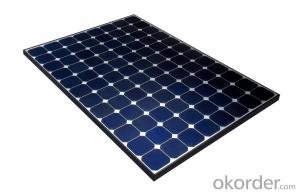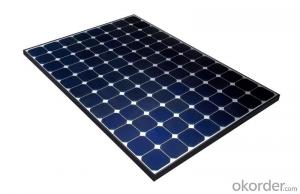Solar Energy Systems for Homes - CNBM On Grid System 60000W with Certificate UL TUV CE
- Loading Port:
- Shanghai
- Payment Terms:
- TT OR LC
- Min Order Qty:
- 10 watt
- Supply Capability:
- 1000 watt/month
OKorder Service Pledge
OKorder Financial Service
You Might Also Like
Specification
CNBM On Grid System 60000W with Certificate UL TUV CE
Product description
They range from small residential and commercial rooftop systems to large utility-scale solar power stations. Unlike stand-alone power systems, a grid-connected system rarely includes an integrated battery solution, as they are still very expensive. When conditions are right, the grid-connected PV system supplies the excess power, beyond consumption by the connected load, to the utility grid.
Connection of the photovoltaic power system can be done only through an interconnection agreement between the consumer and the utility company. The agreement details the various safety standards to be followed during the connection.[4]
The price of solar power, together with batteries for storage, has continued to fall so that in many countries it is cheaper than ordinary fossil fuel electricity from the grid (there is "grid parity").[4]
Off-the-grid is a system and lifestyle[1] designed to help people function without the support of remote infrastructure, such as an electrical grid. In electricity, off-grid can be stand-alone power system or mini-grids typically to provide a smaller community with electricity. Off-grid electrification is an approach to access electricity used in countries and areas with little access to electricity, due to scattered or distant population. The term off-the-grid (OTG) can refer to living in a self-sufficient manner without reliance on one or more public utilities. People who adopt this lifestyle are called off-gridders.[2]
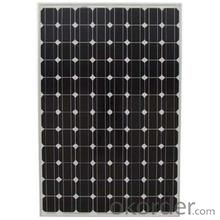
Application
Industrial
Commercial
Residential
Feature
Residential, grid-connected rooftop systems which have a capacity more than 10 kilowatts can meet the load of most consumers.[2] They can feed excess power to the grid where it is consumed by other users. The feedback is done through a meter to monitor power transferred. Photovoltaic wattage may be less than average consumption, in which case the consumer will continue to purchase grid energy, but a lesser amount than previously. If photovoltaic wattage substantially exceeds average consumption, the energy produced by the panels will be much in excess of the demand. In this case, the excess power can yield revenue by selling it to the grid. Depending on their agreement with their local grid energy company, the consumer only needs to pay the cost of electricity consumed less the value of electricity generated. This will be a negative number if more electricity is generated than consumed.[3] Additionally, in some cases, cash incentives are paid from the grid operator to the consumer.
Packaging
With carton and box
- Q: Can a solar energy system be used in areas with high humidity?
- Yes, a solar energy system can be used in areas with high humidity. While it is true that high humidity can affect the performance of a solar energy system to some extent, modern solar panels are designed to withstand various weather conditions, including high humidity. The efficiency of solar panels may decrease slightly in high humidity due to the moisture in the air, but it is not a significant factor that would render solar energy systems ineffective. Additionally, proper maintenance and cleaning of the panels can help mitigate any potential issues caused by humidity. Overall, solar energy systems can still be effectively utilized in areas with high humidity.
- Q: How do solar energy systems connect to the electrical grid?
- Solar energy systems can connect to the electrical grid by means of net metering, a process that enables the system to generate and consume electricity from the grid. Excess power generated by the solar energy system is sent back to the grid and measured by a bi-directional meter, which calculates the flow of electricity in both directions. This surplus electricity is then credited to the system owner's account, effectively reversing the meter. Conversely, during times when the solar energy system is unable to meet the electricity demand, such as at night or on cloudy days, electricity is drawn from the grid to make up for the shortfall. The bi-directional meter accurately records this flow of electricity and measures the amount consumed from the grid. In summary, the connection between solar energy systems and the electrical grid facilitates the seamless integration of renewable energy into the existing power infrastructure. Net metering ensures that solar system owners can contribute excess electricity to the grid and draw from it when needed, resulting in a more efficient, reliable, and sustainable energy system.
- Q: Can solar energy systems be used in areas with high levels of electromagnetic radiation?
- Yes, solar energy systems can be used in areas with high levels of electromagnetic radiation. Solar panels convert sunlight into electricity by utilizing the photovoltaic effect, which is not affected by electromagnetic radiation. However, it is important to note that excessive electromagnetic radiation may cause interference with the electrical components of the solar system, potentially reducing its efficiency. Therefore, proper shielding and grounding measures are crucial to protect the system from any potential damage or interference. Additionally, it is advisable to conduct a thorough site assessment and consult with experts to ensure that the solar energy system can operate optimally in areas with high levels of electromagnetic radiation.
- Q: What is the difference between solar energy systems and solar panels?
- Solar energy systems and solar panels are related but distinct entities. Solar panels are the primary components of a solar energy system. They are devices that convert sunlight into electricity using photovoltaic cells. These cells are made up of semiconductor materials that generate an electric current when exposed to sunlight. Solar panels are typically made up of multiple solar cells wired together to provide a higher voltage and power output. They are often mounted on rooftops or in open spaces where they can capture the maximum amount of sunlight. On the other hand, a solar energy system encompasses more than just the solar panels. It includes all the necessary components and equipment required to harness and utilize solar energy effectively. This includes inverters, which convert the direct current (DC) electricity generated by the solar panels into alternating current (AC) electricity that can be used in homes or businesses. Other components may include batteries for energy storage, charge controllers to regulate the flow of electricity, and monitoring systems to track the performance of the solar energy system. In summary, solar panels are the physical devices that capture sunlight and convert it into electricity, while a solar energy system is a complete setup that incorporates solar panels along with other necessary components to generate, store, and utilize solar energy efficiently.
- Q: How do I monitor the performance of my solar energy system?
- To effectively monitor the performance of your solar energy system, there are several key steps you can follow: 1. Install a monitoring system: First, ensure that your solar energy system is equipped with a monitoring system. This typically involves installing a monitoring device or software that collects and analyzes data from your solar panels, inverters, and other components. Many solar energy systems come with built-in monitoring capabilities, so check with your manufacturer or installer to see if this is already included. 2. Track energy production: Monitoring the energy production of your solar panels is essential to assessing their performance. The monitoring system should provide real-time information on the amount of electricity your solar panels are generating. This data can help you identify any issues or discrepancies in energy production, such as shading or malfunctions, and take appropriate action. 3. Monitor energy consumption: Understanding your energy consumption patterns alongside solar energy production allows you to optimize your system's performance. Consider installing a smart meter or energy monitoring device that tracks your household's energy usage. By comparing energy production and consumption data, you can determine if your system is generating enough electricity to meet your needs or if adjustments are required. 4. Analyze historical data: Regularly reviewing historical data from your monitoring system can provide valuable insights into the long-term performance of your solar energy system. Look for trends, such as seasonal variations in energy production, and compare it to your energy needs. This analysis can help you make informed decisions about system upgrades, maintenance, or future expansions. 5. Set performance benchmarks: Establishing performance benchmarks allows you to measure the effectiveness of your solar energy system. Compare your system's actual energy production against predicted or expected values. If there is a significant deviation, it might indicate a problem with your system that needs to be addressed, such as faulty equipment or suboptimal installation. 6. Regular maintenance and inspections: Conducting regular maintenance and inspections of your solar energy system is crucial for optimal performance. This includes cleaning the solar panels to remove dirt or debris, checking for any physical damage, and ensuring that all components are functioning properly. Monitoring system alerts or notifications can help you identify maintenance needs or potential issues early on. 7. Seek professional assistance if needed: If you are unsure about monitoring your solar energy system or encounter persistent performance issues, it is advisable to seek professional assistance. Solar energy system installers or technicians can help troubleshoot problems, provide guidance on monitoring systems, and suggest improvements to optimize your system's performance. By following these steps, you can effectively monitor your solar energy system and ensure it performs optimally, maximizing the benefits of renewable energy generation.
- Q: Can solar energy systems be used for powering off-grid military operations?
- Yes, solar energy systems can be used for powering off-grid military operations. Solar panels can generate electricity even in remote and austere environments, allowing military operations to have a reliable and sustainable source of power for various needs such as communication equipment, lighting, surveillance systems, and charging batteries. This reduces reliance on traditional fuel-powered generators, lowers logistical challenges, and enhances operational flexibility in off-grid locations. Additionally, solar energy systems offer a quieter and more environmentally friendly power solution, reducing the operational footprint and improving mission security.
- Q: How do solar energy systems affect water quality?
- Solar energy systems have minimal direct impact on water quality. Unlike traditional energy sources such as coal or natural gas, solar energy systems do not release harmful pollutants or emissions. This means they do not contribute to water pollution through the release of toxic substances or thermal pollution. However, it is worth noting that the production and disposal of solar panels can have some indirect environmental impacts, including the potential for water pollution from the manufacturing process or improper disposal of old panels. Overall, though, solar energy systems have a positive effect on water quality compared to other energy sources.
- Q: What is the lifespan of a solar energy system?
- The lifespan of a solar energy system typically ranges from 25 to 30 years.
- Q: Can solar energy systems be installed without professional help?
- No, solar energy systems should always be installed by professionals to ensure proper and safe installation, as well as to maximize their efficiency and longevity.
- Q: What is the impact of hail on solar panels?
- Hail can have a detrimental impact on solar panels, as the forceful impact of hailstones can cause physical damage to the panels. This damage can result in cracks or fractures in the glass or photovoltaic cells, reducing the efficiency and effectiveness of the panels. Furthermore, hail can also impair the electrical connections within the solar panel system, leading to malfunction or complete failure. Therefore, it is important to consider protective measures, such as installing hail guards or utilizing insurance policies, to mitigate the potential damage caused by hail on solar panels.
Send your message to us
Solar Energy Systems for Homes - CNBM On Grid System 60000W with Certificate UL TUV CE
- Loading Port:
- Shanghai
- Payment Terms:
- TT OR LC
- Min Order Qty:
- 10 watt
- Supply Capability:
- 1000 watt/month
OKorder Service Pledge
OKorder Financial Service
Similar products
Hot products
Hot Searches
Related keywords
